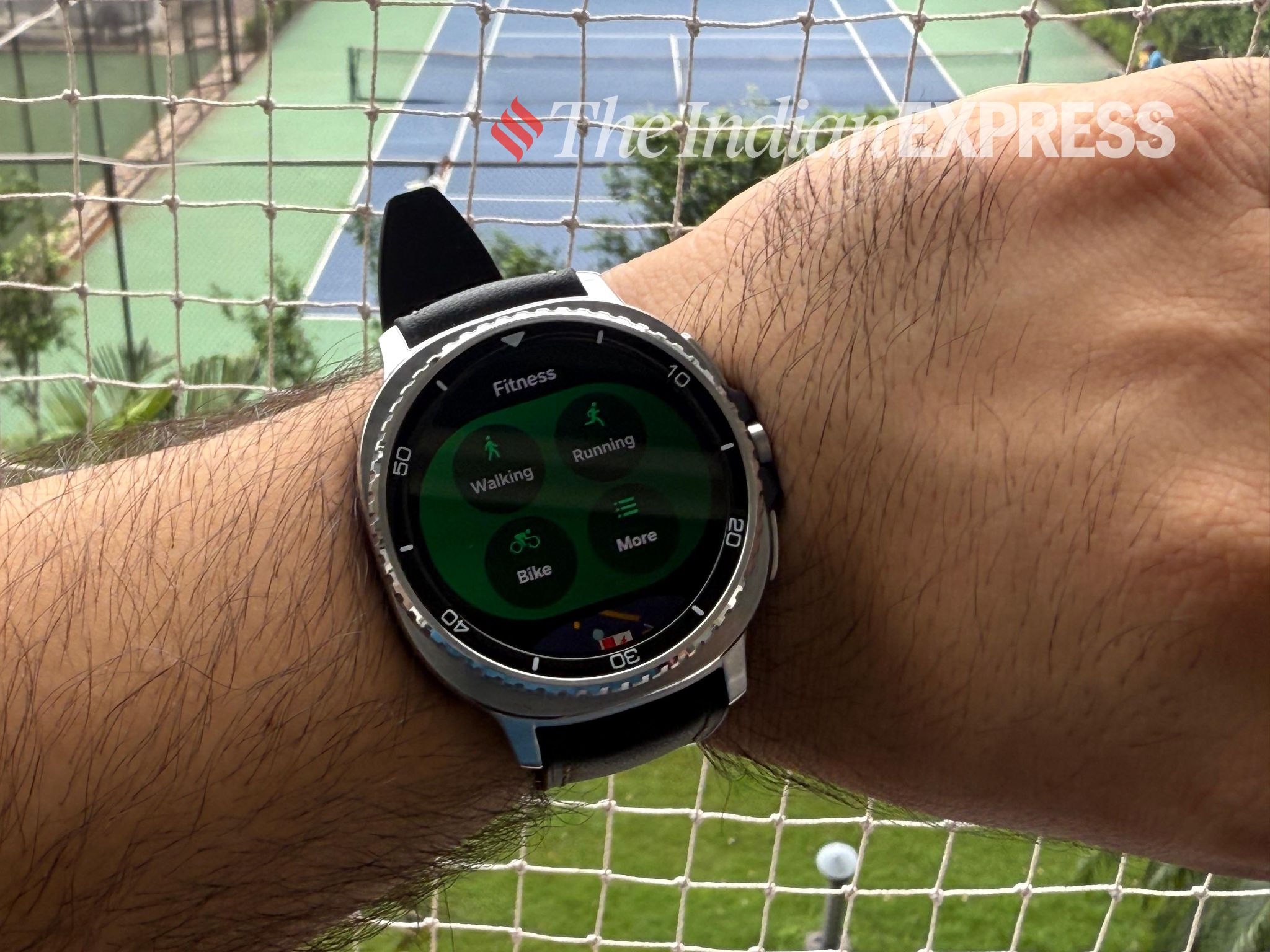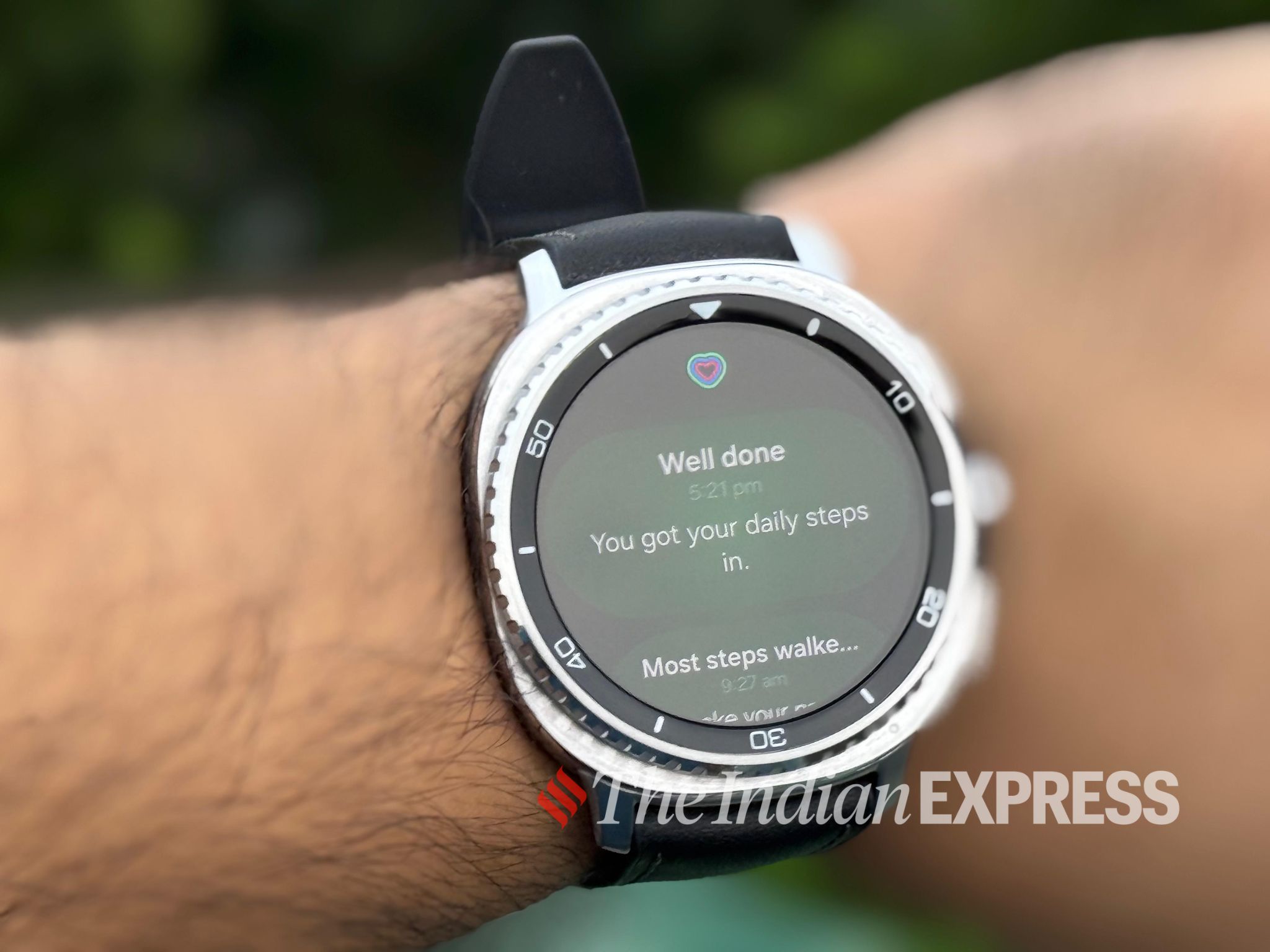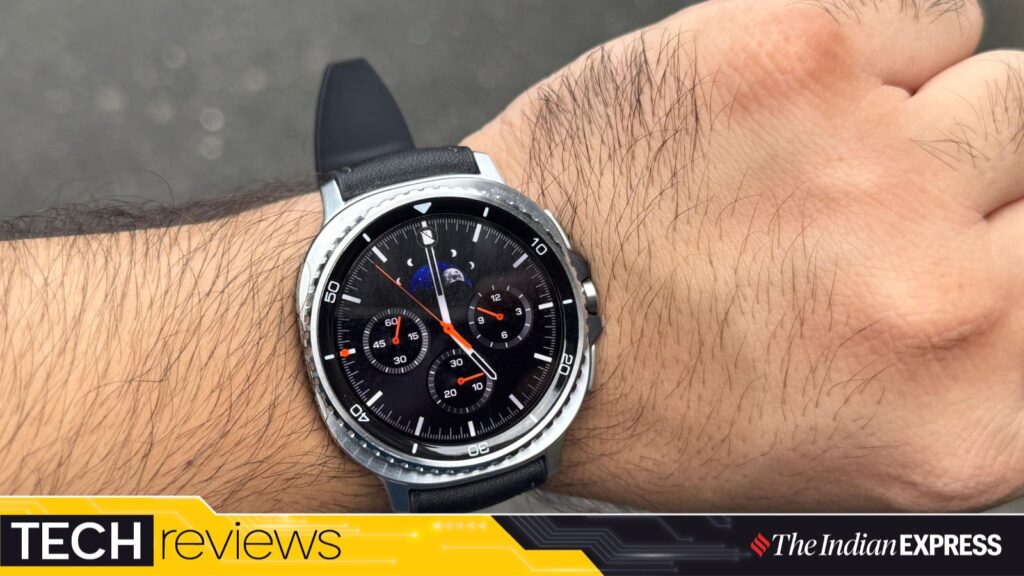970x125
At 35, you have two options: evolve and become more conscious of your health, or continue living as you are, waiting for a major health issue to disrupt your life.
970x125
I prioritised a healthy lifestyle above all else, and while I could manage on my own, the Galaxy Watch 8 Classic became a crucial health tool that helped me tune into my inner consciousness and identify where I had been going wrong with my health over the years.
The Galaxy Watch 8 Classic is the successor to the Galaxy Watch 6 Classic, launching after a two-year gap. Its unconventional design and rotating bezel are unique and cater to a different segment of users. However, where the smartwatch truly shows promise is in putting health at the centre of the experience: this time with a strong focus on AI-powered coaching.
For days, I wore the Galaxy Watch 8 Classic on my wrist, and it stayed on almost the entire day, even after I went to bed. Here’s my review.
What: Samsung Galaxy Watch 8 Classic| Price: Rs 46,999 onwards
Squircle form factor is a personal taste
I have worn almost every smartwatch that’s hit the market over the past decade, and honestly, I’m fed up with seeing Apple Watch clones everywhere. Luckily, the Galaxy Watch 8 Classic keeps its distance from that clone territory and offers a distinct design choice.
 The Watch 8 Classic comes in a 46mm case. (Image: Anuj Bhatia/The Indian Express)
The Watch 8 Classic comes in a 46mm case. (Image: Anuj Bhatia/The Indian Express)
Instead of the typical square or circular base seen on most smartwatches, the Galaxy Watch 8 Classic features a squircle base with a round watch face on top, complete with a rotating bezel. The bezel is mechanical, and yes, it actually rotates (in case you are new to Samsung’s Galaxy Watch line). Rotating the bezel and navigating through the watch’s user interface is satisfying.
I would say the rotating bezel is a truly novel experiment in shaping how users engage with a smartwatch. The whole idea of a mechanical bezel feels old, new, slightly expensive, and accessible too all at once. But more than anything, it brings me a lot of joy and a sense of fun with gadgets that’s often missing these days.
Story continues below this ad
This time, not only is the bezel much thinner, but the watch itself feels more high-end with a stainless steel build and is comfortable to wear. It’s a great fit for anyone, whether you are a startup founder meeting an investor at a hotel coffee shop in Gurugram for the first time, or a runner or cyclist looking for a lightweight smartwatch.
The Watch 8 Classic comes in a 46mm case, which is a bit large for my taste. I wish Samsung had also made a version in a 38mm or 40mm case. That would have helped broaden the appeal of the smartwatch. Currently, the Watch 8 Classic appears to be either too masculine or intended for those with larger wrists.
 Its unconventional design and rotating bezel are unique and cater to a different segment of users. (Image: Anuj Bhatia/The Indian Express)
Its unconventional design and rotating bezel are unique and cater to a different segment of users. (Image: Anuj Bhatia/The Indian Express)
For a change, Samsung has moved away from the universal strap system and introduced a new Dynamic Lug system. Instead of using a tiny pin to swap bands, you simply slide and click to attach or remove the proprietary bands. It’s a similar system introduced on last year’s Galaxy Watch Ultra, as well as on Apple Watches.
The watch comes in two colours: silver and black. I went with the silver, as it gives a more premium look and works well with both casual and office attire. My review unit came with a high-quality band that’s comfortable enough to wear all day. I have very sensitive skin, and in the past, I have experienced rashes during the summer when wearing smartwatches all day.
Story continues below this ad
The Watch 8 Classic also comes with an IP68 rating and a 5ATM water resistance rating, meaning you can swim with the watch but diving is not advised. For that, you should consider the Galaxy Watch Ultra, which is designed for serious athletes and those who are a bit more adventurous.
Personally, I don’t place much emphasis on the looks of a smartwatch. However, I do expect it to be lightweight and comfortable enough to wear for extended periods so that I can track important health metrics. That’s the point why average people buy a smartwatch.
Brighter display and faster performance
From a hardware point of view, not much has changed: except for the new 3nm chip, an upgraded 64GB of storage, and the addition of dual-frequency GPS using both L1 and L5 bands. The chip offers faster performance (though you probably won’t notice much difference). The display is now rated at 3,000 nits of peak brightness, a significant boost from the 2,000 nits on the Galaxy Watch 7.
 The display is now rated at 3,000 nits of peak brightness. (Image: Anuj Bhatia/The Indian Express)
The display is now rated at 3,000 nits of peak brightness. (Image: Anuj Bhatia/The Indian Express)
The 1.34-inch Super AMOLED panel is sharp and colourful, with scratch-resistant sapphire crystal protection. I found it easy to read notifications and check the time even in bright sunlight.
Story continues below this ad
That being said, the 1.34-inch display feels a little cramped but it’s not a dealbreaker. While the regular 44mm Watch 8 has a 1.47-inch display, the Watch 8 Classic, despite having a larger 46mm case, actually has a smaller screen.
The larger Watch 8 Classic is powered by a 445mAh battery, which gave me close to a day and a half of use per charge, including at least one morning workout and overnight sleep tracking with the always-on display enabled. I typically put the watch on my wrist at 6 am every day (I wake up early and go for a walk at 7 am), and it easily lasts all day, even through the night while I sleep.
The watch usually holds out for a few more hours, up until around 12 noon the next day. In comparison, when I wear the Apple Watch, I have to charge it overnight and more often than not, I forget to. I can’t deal with that extra hassle when my days are already long and exhausting.
One Watch UI 8 and Gemini AI
A big reason why I liked the Watch 8 Classic is the user interface, thanks to the new One Watch UI 8. It’s Samsung’s custom interface layered on top of Google’s WearOS, but the Watch 8 Classic feels noticeably different from other WearOS-powered smartwatches.
Story continues below this ad
For example, Samsung moves away from the typical full-screen experience and instead allows multiple tiles to appear on a single screen. The deeper you explore, the more you’ll notice that tiles now come in two sizes (small and large) and you can add multiple tiles to a single page.
 Gemini requires an internet connection (Wi-Fi or LTE) to work. (Image: Anuj Bhatia/The Indian Express)
Gemini requires an internet connection (Wi-Fi or LTE) to work. (Image: Anuj Bhatia/The Indian Express)
In contrast, on most other WearOS smartwatches, tiles and widgets usually take up the entire screen. This makes interacting with tiles much simpler. Now, for instance, you can have a dedicated “Health” page that includes all your health-related tiles without needing to scroll through 10 different pages.
The Now Bar feature is a nice touch, appearing at the bottom of the Watch 8 Classic during different types of live activities. It may seem like a small feature, but it’s actually quite useful in daily use. For example, just by glancing at the watch, you can see how much time is left on a timer without needing to keep the timer app open.
I have always had a conflicted idea of how voice assistants work on smartwatches. That’s mostly because I have been an Apple Watch user, and Siri is, quite honestly, a bare-bones assistant. However, using Google’s Gemini on the Watch 8 Classic was a very different experience and it works well most of the time.
Story continues below this ad
I mean, Gemini makes a lot of sense on the watch. It’s smart enough to find useful information, possibly even a lifesaver when you need it most, without having to take your phone out of your pocket. It can pull up the right landmarks when you are new to a city and exploring unfamiliar places. It’s pretty neat, I would say.
I am glad that Gemini on the Watch isn’t being used for gimmicky features like image creation. On the Watch 8 Classic, Samsung has introduced a new Quick Button, located on the side of the watch body. It can be programmed to launch workouts, open apps, or act as a shortcut to Gemini.
However, keep in mind that Gemini requires an internet connection (Wi-Fi or LTE) to work. So, Bluetooth-only Watch 8 Classic users will need to have their phone nearby, or opt for the Watch 8 Classic with LTE connectivity, which costs Rs 50,999.
A health tool in the making
When I wore the Watch 8 Classic at the Unpacked event in New York in June, I had already made up my mind that I wanted to use the watch more as a health tool than just for timekeeping. I was very clear about this because I had already started taking my health seriously and was in the midst of a transition.
Story continues below this ad
Smartwatches are jam-packed with sensors and health features, but how that data is delivered to you and what you do with it is what really matters. The Watch 8 Classic feels like a much more mature smartwatch compared to Samsung’s last few models. Its health features, though abundant, are less finicky and more data-driven. That said, not all of its health features are perfect.
 Running Coach isn’t aimed at advanced runners. (Screenshot: Samsung Health app)
Running Coach isn’t aimed at advanced runners. (Screenshot: Samsung Health app)
You get new metrics for cardiovascular health, a skin-based antioxidant index, improved bedtime guidance, and a personal running coach. All these tools take advantage of Samsung’s advanced BioActive sensor, which is available only on the Series 8 models (and the Ultra). That said, none of these features is medical grade, and it’s always advisable to consult a doctor.
The Watch 8 Classic’s step count and heart rate tracking are almost spot-on, and even the sleep tracking, for that matter, matches what I get from my Apple Watch. The dual-band GPS has also been consistent, quickly getting a signal and accurately mapping my outdoor runs and walks without any major issues. However, I did experience problems with the SpO2 tracking on the Watch 8 Classic. It felt inaccurate and inconsistent at times.
The Watch 8 Classic also features the world’s first antioxidant reader, which measures the level of antioxidants in your blood through a thumb reading. You receive a score between 0 and 100, which falls into one of three categories: very low, low, or adequate. The Watch 8 Classic indicated that my Antioxidant Index was low, despite my maintaining a balanced diet. I am still unsure whether to rely on this index or take it with a grain of salt.
Story continues below this ad
There’s also a new metric called Vascular Load, which measures the strain on your heart during sleep. These readings are presented on a low-to-high scale to help you understand how certain behaviours like alcohol intake may be contributing to your long-term risk of heart disease. I plan to continue monitoring this feature to see how useful it proves to be over time.
 The Watch 8 Classic indicated that my Antioxidant Index was low. (Screenshot: Samsung Health app)
The Watch 8 Classic indicated that my Antioxidant Index was low. (Screenshot: Samsung Health app)
I spent a lot of time testing Running Coach, a virtual coach that gives you personalised training plans and real-time feedback to help you get back in shape. It starts with a brief questionnaire on your phone about your running and workout habits. Then, it asks you to log your longest run in the past three months.
The idea behind Running Coach is to first understand your physical condition, and based on that, assign personalised workout plans. The runs are pace-based, with Running Coach providing on-screen guidance and audio cues to help you stay on track.
Look, Running Coach isn’t aimed at advanced runners. It’s more for people like you and me. It encourages and pushes you while helping you become more aware of where you have been going wrong. It also helps you start understanding your running data so you can get fitter over time.
However, the results don’t show immediately; it takes time for Running Coach to improve and adjust your training plan as it gathers more data from your runs. I think there’s a lot of potential in Running Coach, and it will only get better if Samsung continues to update it with new features. All of this information is then visible in the Samsung Health app.
Should you buy the Samsung Galaxy Watch 8 Classic?
What makes the Watch 8 Classic exciting is that it sits at the intersection of both strong hardware and thoughtful software. Of course, it doesn’t have Garmin’s advanced fitness software, but I think Samsung has succeeded in making it simple to interact with the smartwatch and track your health metrics, that’s what really works here.
The Watch 8 Classic is genuinely refreshing, bringing together a cool, innovative mechanical rotating bezel design and a wide range of health features in one place. That being said, none of these health features are clinically verified, and they aren’t meant to replace medical-grade tests.
Still, I would urge you to start taking your health more seriously and become better at understanding your health data. That’s what the Galaxy Watch 8 Classic is trying to be: not your doctor, but a health coach that guides you to get fitter and take action before it’s too late.
970x125

